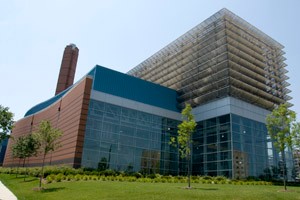
UC Closer to Moving Beyond Coal
Coal, an oft-maligned fossil fuel, could soon be history at the University of Cincinnati.
For years, UC has dramatically tempered its reliance on coal combustion for energy. Statistics from UC's Utilities Services show current coal usage is around 90 percent less than what it was in fiscal year 2011. Joe Harrell, Utilities assistant vice president, anticipates the university could completely supplant coal as its primary solid fuel within a year's time.
"UC has always been a leader in environmental stewardship, and a great example of our innovation is how UC is moving beyond coal," Harrell says. "We're working diligently to eliminate that last 10 percent of coal use."
COAL USAGE BY THE NUMBERS
UC's reliance on coal-fired energy remains historically low. Here's a look at coal use from the past five fiscal years:
- Coal usage 2009: 33,990 tons
- Coal usage 2010: 30,543 tons
- Coal usage 2011: 24,007 tons
- Coal usage 2012: 728 tons
- Coal usage 2013: 636 tons
Decreased reliance on coal is an important element in Utilities Services mission to provide a safe, healthy and comfortable environment for the university community. For the past year, Utilities Services has been testing alternative solid fuels, including renewable paper pellets, for use in the coal boiler.
The pellets being tested are made from waste materials such as industrial papers and plastics that cant be recycled. If left to decompose in landfills, these materials would eventually produce methane, a more powerful atmospheric toxin than carbon dioxide. Instead, these materials are shredded, pressed and shaped into a dense pellet thats about the size of a $1 stack of dimes. These pellets can be used as a cleaner, more cost-effective substitute for coal. Utilities Services has been assisted on this project by UC's Planning + Design + Construction, College of Engineering & Applied Science and Environmental Studies Program.
"This collaboration has been so successful that UC will be able to move completely beyond coal with less than $1,000,000 of capital costs," Harrell says.
UC has applied for a permit from the U.S. Environmental Protection Agency to add pellets to the fuel mix, and Harrell anticipates approval soon.
SAVING ENERGY MEANS SAVING MONEY
At the same time UC has experienced
record-setting enrollment in recent years
, many departments working together have managed to reduce the university's overall energy usage. Total energy use intensity (measured in kBtu per gross square feet) in fiscal year 2013 was down from the previous year, continuing a three-year trend. Harrell says these recent energy savings have allowed UC to avoid more than $4,500,000 of cost increases per year.
The EPA has recognized UC multiple times for its efficient operation of the Central Utility Plant, which produces energy via the cogeneration method. This process uses one fuel source to produce thermal energy and electricity an environmental and economic advantage over the conventional, multi-fuel-sourced separate heat and power method.
UC's utility plant also has gotten attention this year from the International District Energy Association (IDEA). A student-produced
video about UC's responsible approach to energy management
won the grand prize in IDEA's third annual Campus Energy Video Contest. Video submissions were required to be fewer than three minutes long and focus on the campus energy plant's use of district energy and/or combined heat and power. Winners were announced at IDEA's 27th annual Campus Energy Conference held in February in Atlanta.
IDEA is a nonprofit association for district energy professionals that promotes reliable, economical, efficient and environmentally sound district energy services. District energy systems produce steam, hot water or chilled water at a central location to be distributed to a network of buildings.
SUSTAINABILITY AT UC
These sustainable energy efforts not only align with the
goal to create a deliberate and responsible approach to our environment and to UC's resources and operations, but they are a few more examples of what it means to be
. The university recognizes its role as a leader in sustainable practice, research and education. UC seeks to consider the environmental, social and economic impacts of its decisions and is committed to incorporating the concept of sustainability into its academic and research programs; the design, operation and maintenance of its buildings and landscapes; and its organizational structure and management.
MORE UC NEWS RELATED TO EARTH DAY
Spring 'Greening' for Earth Day: UC Earns National Sustainability Ranking
More than Just the Grass is 'Greener' at UC
Related Stories
UC’s Ground Floor Makerspace births combat robots
April 17, 2024
In the heart of UC's 1819 Innovation Hub lies the Ground Floor Makerspace, an advanced and active hub of ingenuity where students, faculty and the community converge to bring their ideas to life. This includes being the birthplace of robots much like miniature race cars, combating fender to fender in an enclosed boxing ring. Combat robots like UC's Maximizer will again be fighting for first place in the National Havoc Robot League (NHRL) competition, slated for April 20.
UC researchers develop new CPAP device
April 17, 2024
Researchers at the University of Cincinnati are developing a VortexPAP machine that takes advantage of vortex airflow technology. A preliminary clinical study with current CPAP users demonstrated that the VortexPAP can deliver the pressure levels that are used in the subjects’ CPAP therapy, but the mask is more comfortable to wear. It has a minimalistic design that is less intrusive and barely touches the patient’s face.
UC architectural engineering alumna inspires high school students
April 16, 2024
University of Cincinnati alumna Emma Wilhelmus fell in love with engineering when she was in ninth grade. After taking drafting, architecture and engineering courses in high school, she set out to major in architectural engineering in college. Now, she is an engineering teacher at a local high school and hopes to inspire students.
